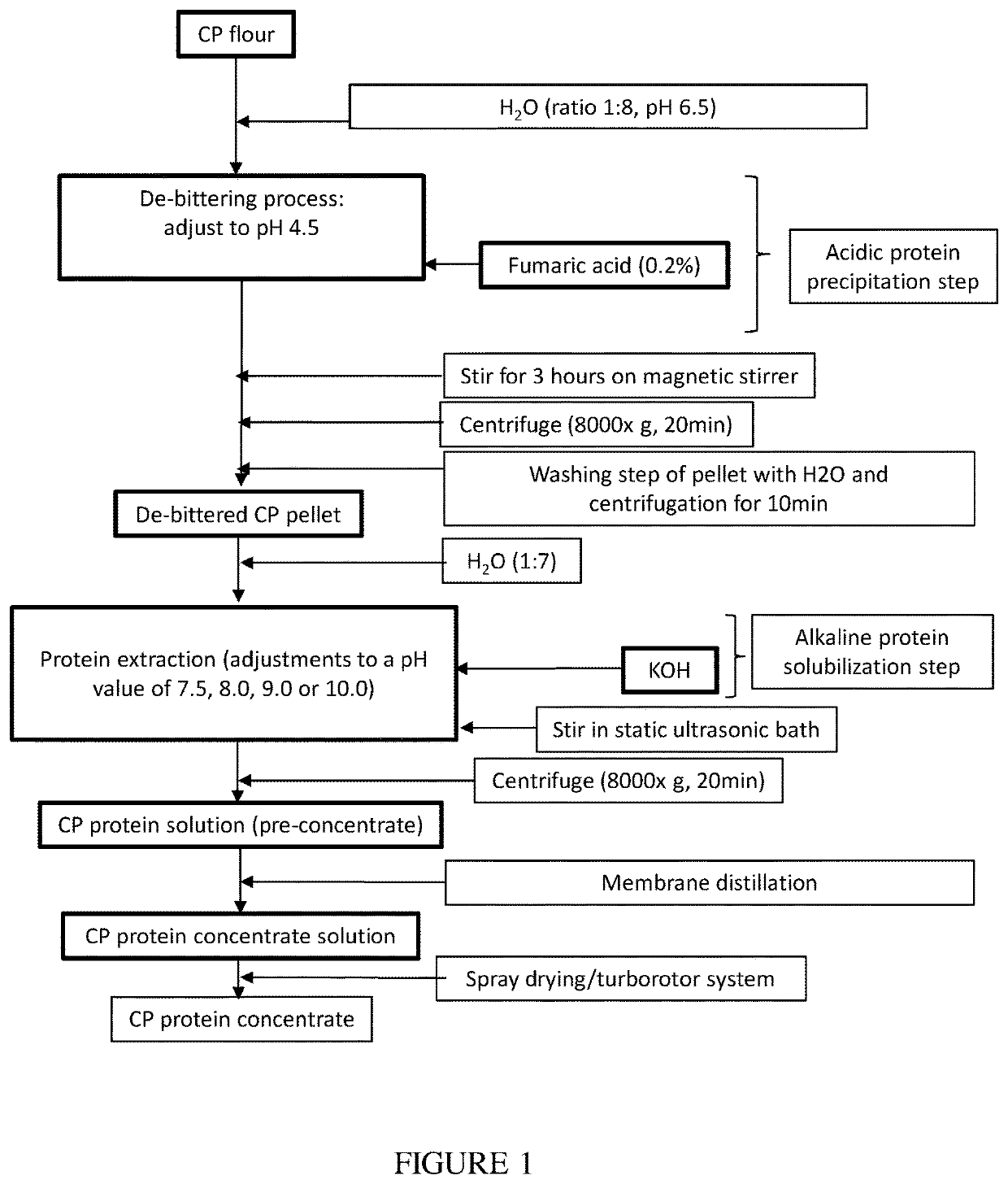Chickpea protein concentrate
a technology of chickpea protein and concentrate, which is applied in the field of palatable chickpea protein concentrate, can solve the problems of affecting the taste of soy based foods, the inability of meat substitutes to fully meet consumer preferences in sensory quality, etc., and achieves the effect of less bitterness
- Summary
- Abstract
- Description
- Claims
- Application Information
AI Technical Summary
Benefits of technology
Problems solved by technology
Method used
Image
Examples
example 1
Bitterness of Chickpea Flour
[0135]To remove chemical compounds that have a bitter taste, such as saponins, the chickpea protein was extracted in acid conditions. Chickpea flour was mixed with H2O or distilled H2O (ratio 1:10) and brought to homogenization using a magnetic stirrer (MR3001, Heidolph instruments, Schwabach, GER). Sulfuric acid (H2SO4), phosphoric acid (H3PO4), hydrochloric acid (HCl), fumaric acid, or citric acid was used to adjust the pH to 4.5. At this pH, most antinutritive and bitter components are soluble, whereas the proteins are insoluble. The composition was extracted on a magnetic stirrer for three hours, followed by centrifugation at 8000×g for 20 minutes. The supernatant was discarded, and the sediment was suspended and washed with water. Next, the mixture was centrifuged at 8000×g for about ten minutes; the sediment was weighed and stored for sensory evaluation. Table 1 shows the experimental design and results of the debittering process.
Sensory Evaluation
[...
example 2
xtraction
[0137]The debittered sediments from example 1 were subjected to an alkaline protein extraction. Since fumaric acid and HCl were found to be acceptable in terms of bitterness reduction, they were subjected for further analysis. For extraction of protein, the sediments were dissolved in H2O at a ratio of 1:8. The sediment-water mixtures were adjusted to different pHs (7.5-10) using sodium hydroxide (NaOH) or potassium hydroxide (KOH). After stirring overnight at room temperature, the mixture was centrifuged at 8000×g for 20 minutes. The content of the supernatant and sediment was evaluated. Approximately 3 g of sample was weighted into dried petri dishes, and dried with open cover at 103° C. for one hour in a drying oven (Memmert GmbH & Co. KG, Schwabach). The petri dishes were cooled to room temperature in an exsiccator and weight loss was recorded. The drying procedure was repeated until there was no weight loss or the weight increased again because of oxidation processes i...
PUM
| Property | Measurement | Unit |
|---|---|---|
| temperature | aaaaa | aaaaa |
| temperature | aaaaa | aaaaa |
| pH | aaaaa | aaaaa |
Abstract
Description
Claims
Application Information
 Login to View More
Login to View More - R&D
- Intellectual Property
- Life Sciences
- Materials
- Tech Scout
- Unparalleled Data Quality
- Higher Quality Content
- 60% Fewer Hallucinations
Browse by: Latest US Patents, China's latest patents, Technical Efficacy Thesaurus, Application Domain, Technology Topic, Popular Technical Reports.
© 2025 PatSnap. All rights reserved.Legal|Privacy policy|Modern Slavery Act Transparency Statement|Sitemap|About US| Contact US: help@patsnap.com

